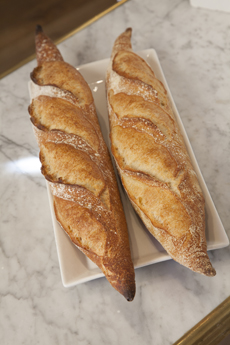TIP OF THE DAY: How To Find The Best Baguette
 Beautiful baguettes from Maison Kayser in New York City. The artistic flair of the bakers adds to the visual appeal, but the taste’s the thing. Photo courtesy Maison Kayser. |
There’s a lot of bad bread in America: spongy, flavorless, aroma-less, a waste of carbs masquerading as “good bread.” This is especially true when you have expectations for a specialty loaf like a baguette.
The longest of loaves, a baguette is narrow with a very crusty, amber-colored outside and a delicate, tender crumb (inside). A baguette is three or four inches in diameter and can be up to a yard long, although it is typically about two feet in length. (See our Bread glossary for the different types of bread, including the different types of French bread). If you live in a large city, you can buy a baguette in any food-centric neighborhood. But is it great, passable or merely “masquerading” as a baguette? This article is a tutorial from Maison Kayser, a boulangerie and pâtisserie* that has people standing in line for its baguettes in Paris and at a number of global outposts. “Good bread doesn’t lie,” says founder Eric Kayser. “It says everything about the quality of its ingredients and the know-how of its creator.” Executive master baker Yann Ledoux of Maison Kayser in New York City gave us this valuable lesson in understanding great baguettes: |
|
|
INGREDIENTS All ingredients are not created equal, even when they’re as seemingly simple as flour, water, salt and levain (sourdough starter). (There’s more about Maison Kayser’s levain and flour later in this article.) And all training is not equal: The best bread bakers have extensive training from masters, and bring their own passion and commitment to quality and to creating loaves that lead to lines of customers snaking around the corner. Ledoux attributes these percentages to the creation of a great baguette: †Each municipal water supply imparts unique undertones of flavor. HOW TO BUY THE BEST BAGUETTE You can tell a lot just by looking at the baguette. If you want to follow this lesson closely, pick up all the different baguettes you can and compare them to each other. You can turn it into a wine and cheese party and demonstrate this information. Start By Looking A Great Baguette |
||
|
THE TEXTBOOK PERFECT CRUST & CRUMB
Bread is divided into the external crust and the internal crumb. Cut a six-inch piece from the baguette in half and examine the crumb. Crumb The perfect crumb should have small air holes that are present consistently throughout the baguette. It should have a certain level of elasticity, so when you press it with your fingers it always returns to its original shape and form. If it does not return, it is because the crumb is either too dense (not fermented enough), too moist (not baked enough) or too hard (not fresh enough). The texture of the crumb should have a creamy color, taste and smell of hazelnut and have a hint of acidity that brings a balance and enhances the flavors within the baguette. If the holes in the bread are vastly varied in size, if the color is cream rather than white, if you can smell the delicious aroma of the levain and hear a crisp crunch while squeezing the crust, then (voilà!) you have the best baguette. |
 The inside, called the crumb, of a great baguette. Photo courtesy Maison Kayser.. |
|
|
Crust The crust should have a beautiful consistent golden brown (amber) color throughout the entire baguette, except at the scoring, where the color is slightly lighter. What sets a great baguette apart is the use of homemade, mineral-rich, natural liquid levain, which achieves a richer balance and flavor than commercially purchased starters. At Maison Kayser there is no commercial yeast or pre-mixed dough arriving in freezer containers from Paris: Everything is made from scratch on the spot. Although baking with liquid levain is a timely process, it is an essential element of a true artisanal, hands-on process to enable the sourdough to reach its full potential. At Maison Kayser, the liquid levain is constantly monitored by a trained baker and tested for acidity, texture and aroma. As a result, the baguette has a stronger flavor, a slight hazelnut taste in the crumb and an appealing—we say “beguiling”—aroma. As importantly, the baguette made with liquid levain bestows a longer shelf life (how often has the afternoon’s baguette become brick-hard by evening?). Baker’s secret: In addition to the organic flour sourced in upstate New York, Maison Kayser uses a little bit of Gaude flour imported from France. Made from roasted corn, Gaude gives the bread the nutty, sourdough flavor and creamy, yellowish hue, rather than the stark white of too many American baguettes. Fermentation “Greatness cannot be rushed,” says Yann Ledoux, and the best baguette doesn’t rush things. The proper method involves a longer and slower fermentation or rising of the dough. Each of Maison Kayser’s baguettes takes 12 hours from mixing to baking. Artistry Great bakers enjoy creating a “signature” baguette. Eric Kayser likes to create different signature baguettes based on the neighborhoods in which his bakeries are located. For example: While it is the longest loaf, baguette means “a small rod” in French. ‡Maison Kayser is located at 1294 Third Avenue, between 74th and 75th Streets. |
||


